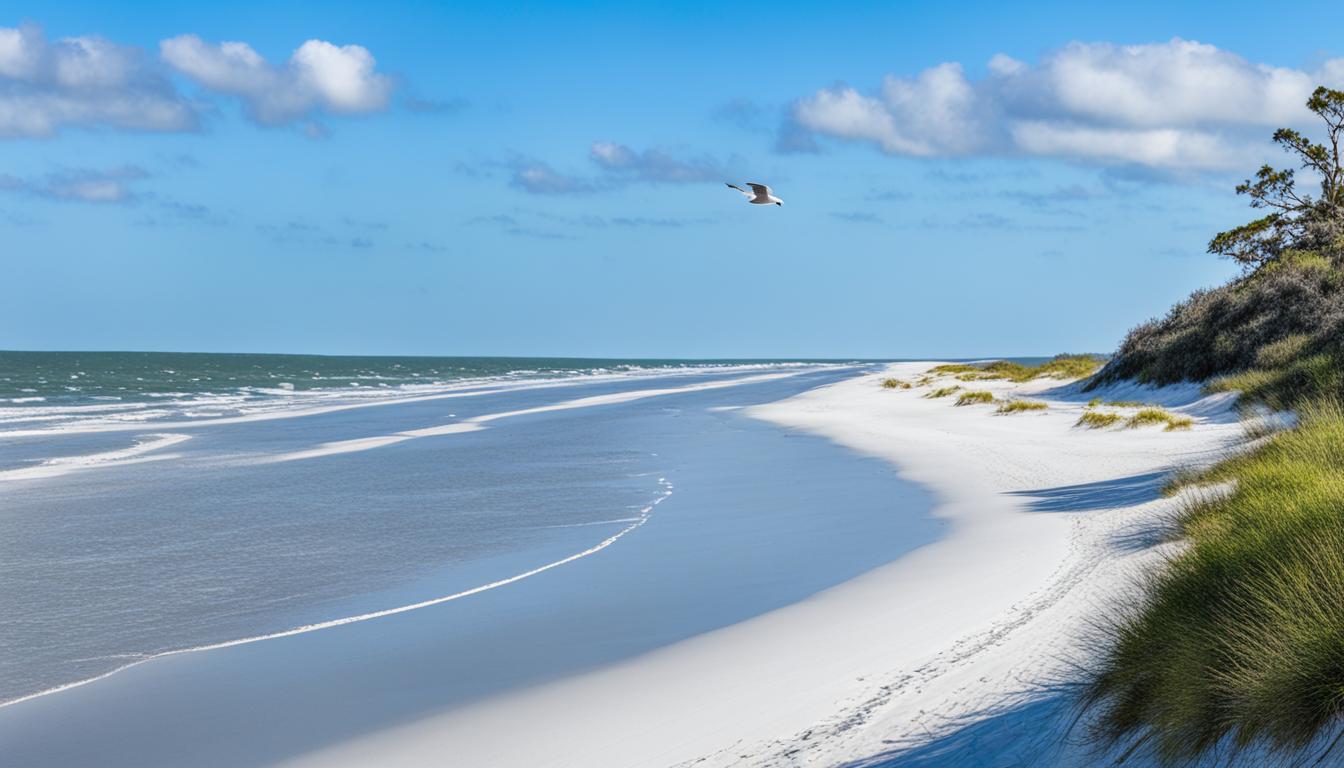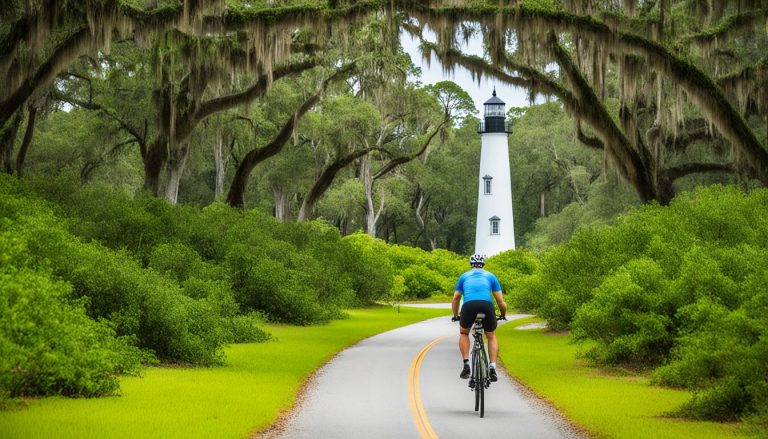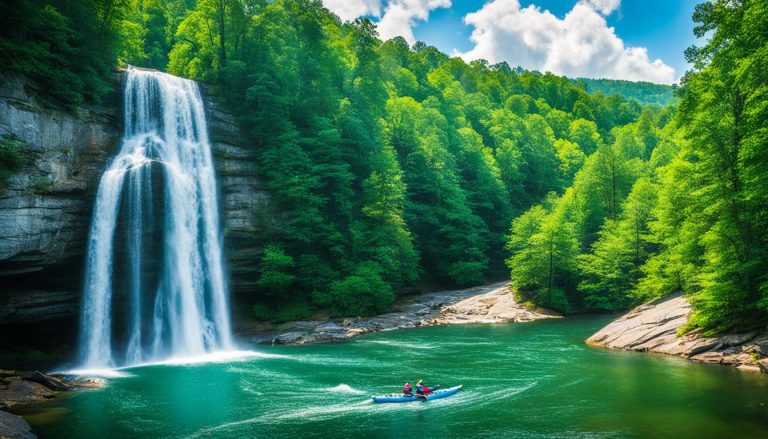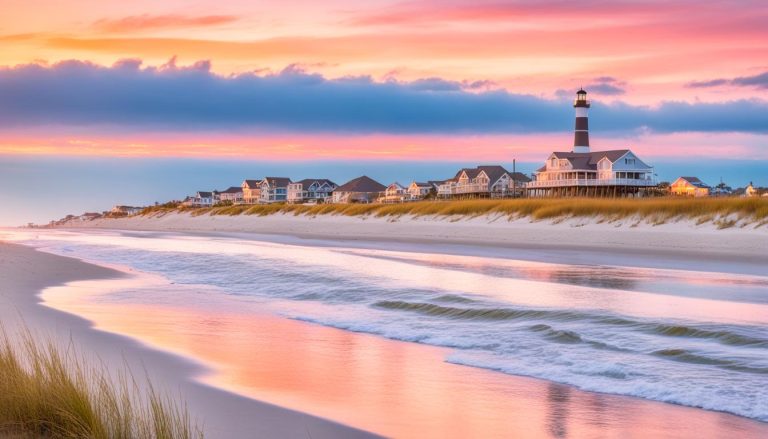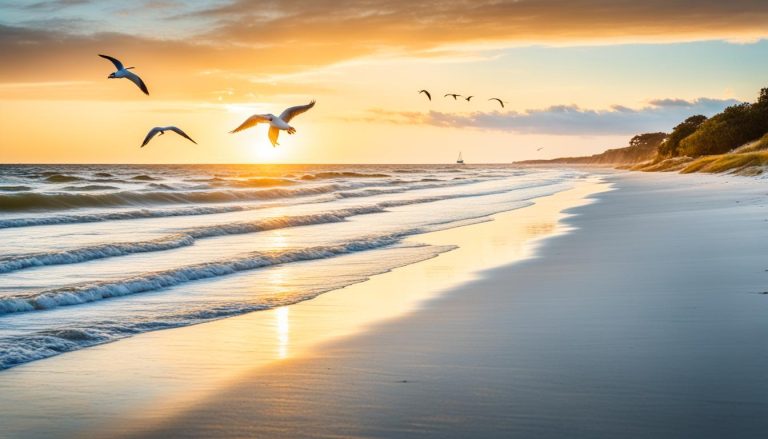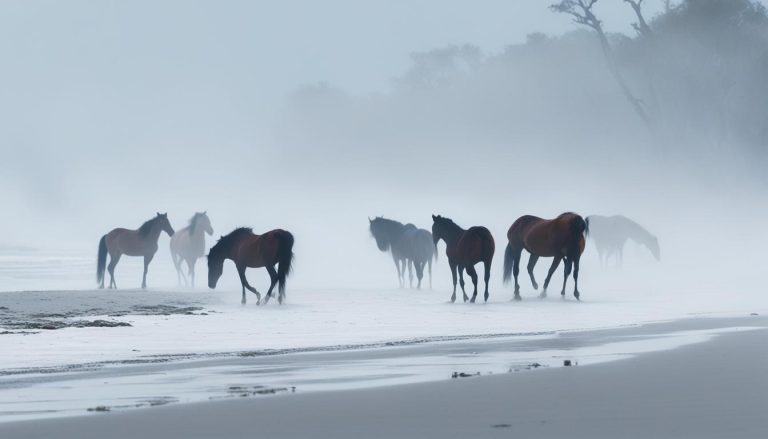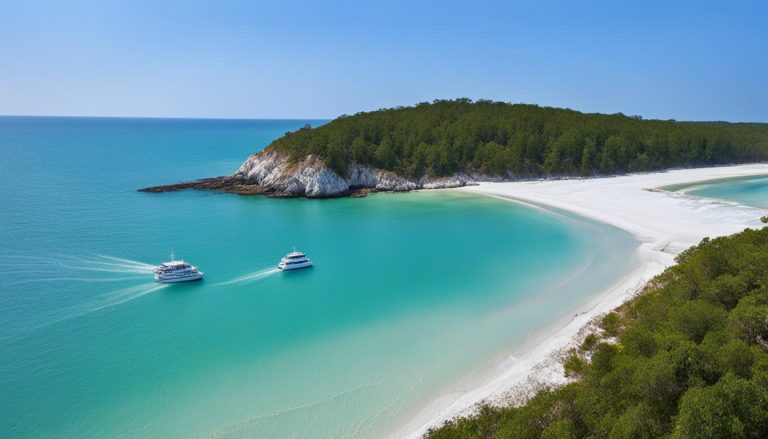Ever dreamed of exploring a pristine island full of natural wonders and history? Cumberland Island National Seashore in Georgia is a must-see. It’s the largest barrier island on the Georgia coast. Here, you’ll find stunning natural beauty, historic sites, and diverse wildlife that will amaze you.
Key Takeaways
- Cumberland Island is Georgia’s largest barrier island, spanning about 40 square miles.
- The island is home to a diverse array of wildlife, including wild horses, loggerhead sea turtles, armadillos, alligators, and deer.
- Visitors can explore historic sites, hike nature trails, enjoy beach activities, and participate in guided tours and educational programs.
- Accommodations range from primitive camping to a historic luxury hotel, and the ferry service provides access to the island.
- The best time to visit is during the summer months or the shoulder seasons for milder weather conditions.
Introduction to Cumberland Island National Seashore
Overview of the Island's Natural Beauty and History
Cumberland Island is a gem with untouched beaches, ancient oak tunnels, and a wide variety of wildlife. Its history goes back to the 1700s, when Native Americans, Spanish, British, and Americans lived there. Famous people like Revolutionary War leader Nathanael Greene and the Carnegie family have left their mark.
Today, the island is mostly untouched, without condos, traffic, or restaurants. This makes it a special place for those who love nature and history.
Accessibility and Getting to Cumberland Island
You can only get to Cumberland Island by boat since there are no car ferries. The main way to visit is by taking the Cumberland Island ferry from St. Marys, Georgia. This ferry can carry 145 passengers and makes two trips daily, at 9:00 am and 11:45 am.
The 45-minute ferry ride is scenic and might let you see dolphins. Remember, you need to buy separate tickets for going and coming back. Booking ferry tickets early is a good idea, especially on weekends when it might sell out.
| Key Facts about Cumberland Island | Value |
|---|---|
| Visitation Limit | 300 people per day |
| Total Acreage | 23,000 acres (including marshlands) |
| Beach Length | 17.5 miles |
| Pleistocene Age | Around 35,000 years old |
| Feral Horses | 120-150 |
| Bird Species | Over 277 identified |
| Loggerhead Turtle Nests | Average 198 per year |
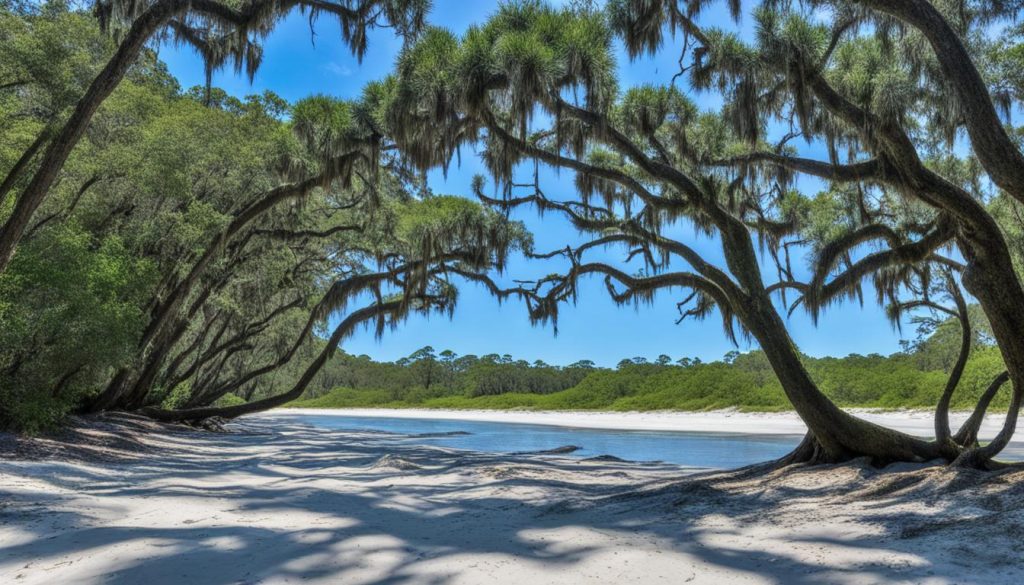
“Cumberland Island is a true natural treasure, boasting pristine beaches, ancient oak tree tunnels, and diverse wildlife.”
Exploring the Historic District and Dungeness Ruins
Cumberland Island, Georgia’s largest barrier island, takes you back in time. It’s a place where history comes alive. The Historic District is a key spot, about 1.5 miles from the Sea Camp ferry dock. Here, the ruins of the Carnegies’ 59-room Dungeness mansion stand, destroyed by fire in 1959.
Walking through, you’ll see the old ice house turned into a museum. The National Park Service offers free tours of the Historic District and Dungeness ruins. These tours are great for learning about the island’s history and the Carnegie family who lived here.
“The Dungeness Ruins are a testament to the island’s rich history and the remarkable legacy of the Carnegie family.”
The Dungeness ruins and the Cumberland Island historic district show the island’s past. They let you picture the grand life of the Carnegies and their families. Whether by yourself or with a guide, the historic district is a key spot for history lovers.
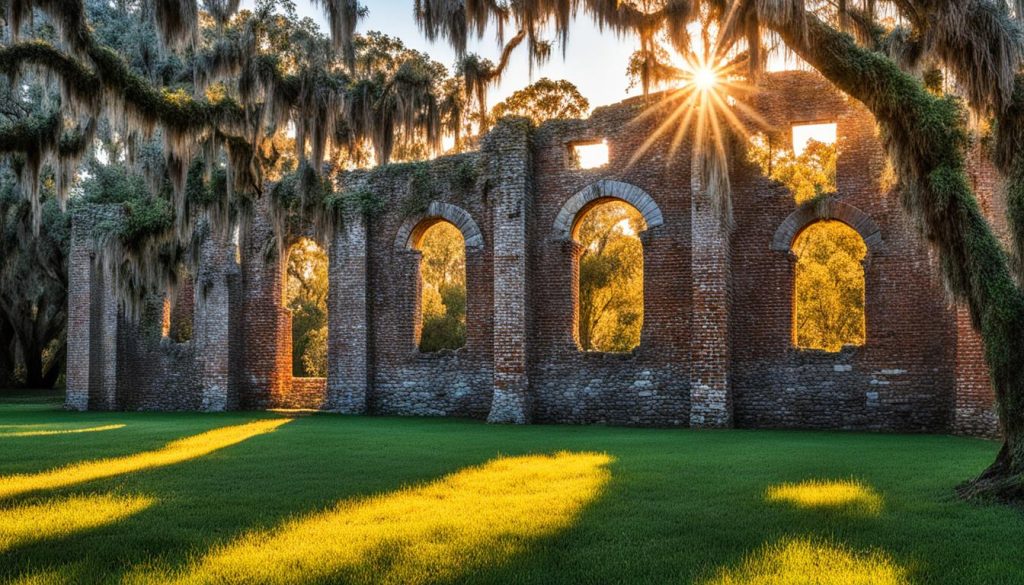
Wildlife Watching: Feral Horses and Other Inhabitants
Cumberland Island National Seashore is a great place to see wildlife, especially the wild horses. These horses live freely on the island. They range from small ponies to big horses. You can see them near the Historic District and Dungeness ruins.
Tips for Safely Observing the Wild Horses
It’s exciting to watch the wild horses, but be careful. Keep at least 20 feet away from them. If they come closer, slowly move back. This way, you can enjoy watching them without any problems.
Other Wildlife on Cumberland Island
Cumberland Island has more than just wild horses. You can see deer, wild turkeys, armadillos, feral pigs, coyotes, and many birds. Look out for loggerhead sea turtles and dolphins too. The island’s beaches and trails are perfect for watching wildlife and birds.

| Wildlife on Cumberland Island | Population Estimates |
|---|---|
| Feral Horses | 150-170 |
| Deer | Unknown |
| Wild Turkeys | Unknown |
| Armadillos | Unknown |
| Feral Pigs | Unknown |
| Coyotes | Unknown |
| Bird Species | Over 300 |
| Loggerhead Sea Turtles | 885 nests in a single year |
| Dolphins | Unknown |
Hiking and Nature Trails
Walking through Cumberland Island’s natural beauty is a joy. The island has many hiking trails that take you through different landscapes. You’ll see sandy beaches, oak tree tunnels, and vibrant marshes. The Southend Loop and the Parallel Trail are two popular paths.
Popular Hiking Trails on Cumberland Island
Cumberland Island has over fifty miles of sandy trails for hiking. It has over 16 miles of shoreline and maritime forests. This means there are many places to explore and discover.
- Southend Loop: This trail takes you to the historic Dungeness ruins, showing the island’s rich history.
- Parallel Trail: This trail offers beautiful views of the coastline and its wildlife along the western edge.
Tips for Hiking and Exploring the Island
When hiking on Cumberland Island, be ready and respect the island’s nature. Wear comfy shoes and bring water, snacks, and sun protection. Don’t forget insect repellent, as mosquitoes can be a problem in summer.
Always stay on marked trails to protect the island’s delicate areas. Remember to take all your trash with you to keep the island beautiful.
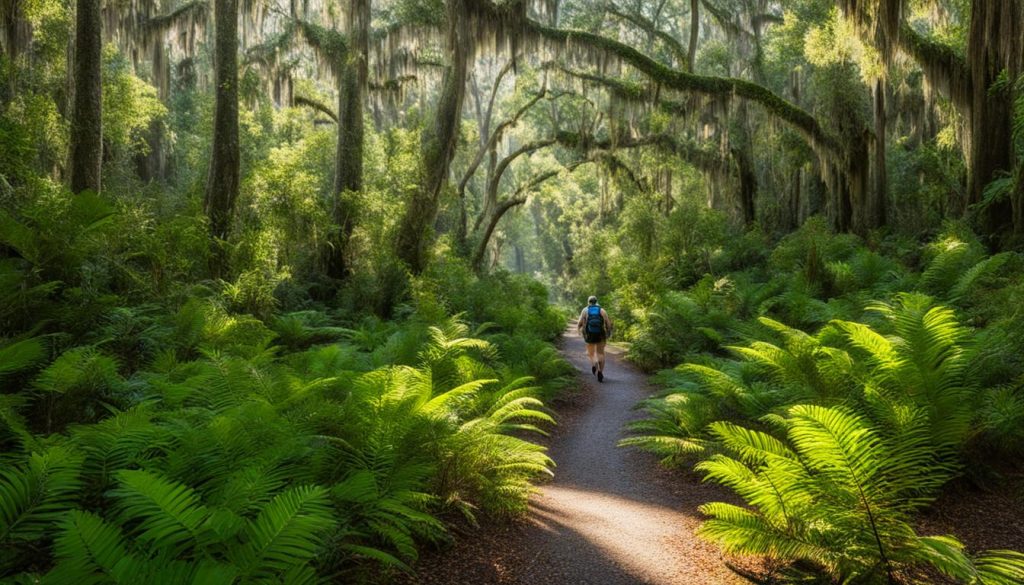
Cumberland Island National Seashore, Georgia: Best Things to Do - Top Picks
Cumberland Island National Seashore is a hidden gem off Georgia’s coast. It’s one of the largest undeveloped barrier islands on the East Coast. Visitors can enjoy a variety of activities and experiences in this 36,000-acre haven.
Exploring the historic Dungeness ruins is a top activity on Cumberland Island. You can see the remains of a grand 19th-century mansion. Also, don’t miss the Plum Orchard mansion, a symbol of the island’s gilded age.
Nature lovers will find plenty to do here. Cumberland Island is home to over 300 bird species, including bald eagles and painted buntings. Keep an eye out for the island’s famous feral horses.
Outdoor enthusiasts will love the island’s hiking trails. Trails like the Parallel and Riverview offer beautiful landscapes and views. Don’t forget your hiking boots and camera.
Guided tours are another great way to learn about the island. The Lands and Legacies Tour, led by park rangers, explores the island’s history and ecology.
Cumberland Island National Seashore has activities for everyone, from history buffs to outdoor lovers. Start an unforgettable journey and discover the best of this Georgia gem.
“Cumberland Island is a place of great natural beauty, where the past and present merge to create an unforgettable experience.” – National Park Service
Camping and Overnight Stays
Visitors looking to stay longer on Cumberland Island have two main choices. Camping is one, with five campgrounds run by the National Park Service. These are Sea Camp, Stafford Beach, Hickory Hill, Brickhill Bluff, and Yankee Paradise.
Camping here means a simple, nature-focused stay with no extra comforts. You must get a permit early since these spots are popular and go fast.
Campgrounds on Cumberland Island
- Sea Camp
- Stafford Beach
- Hickory Hill
- Brickhill Bluff
- Yankee Paradise
Another choice is the Greyfield Inn, a historic Carnegie mansion turned luxury hotel. It offers a fancy stay with a touch of history and beauty.
Whether you pick camping or the Greyfield Inn, your visit to Cumberland Island will be memorable. It boasts beautiful beaches, diverse wildlife, and a rich history. This place is a unique escape.
Beach Activities and Coastal Exploration
The beaches of Cumberland Island are a big hit with visitors. They stretch for 17 miles along the eastern edge of the island. Here, you can swim, sunbathe, comb the beach, and enjoy the peaceful coast. You can also explore the island by boat, either on a guided tour or in your own kayak.
Boat tours let you see dolphins and take in stunning views of the Atlantic Ocean. You can also see the island’s marshes and waterways.
For those who love exploring the coast, Cumberland Island has a lot to offer. You can go on kayak tours to see wildlife up close. Or, you can use the boat ramps to go fishing, boating, or dolphin watching.
The outdoor activities on Cumberland Island are truly amazing. Whether you want to relax on the beach, explore the coast, or learn about the island’s history, there’s something for everyone.
| Activity | Duration | Price Range |
|---|---|---|
| Guided Kayak Tour | 2-3 hours | $45-$75 per person |
| Boat Rental | Half-day or full-day | $150-$350 per rental |
| Beach Combing | Varies | Free |
| Dolphin-watching Excursion | 1-2 hours | $30-$50 per person |
Looking for relaxation, adventure, or a closer connection with nature? The Cumberland Island National Seashore has plenty of coastal exploration and beach activities for unforgettable moments.
Guided Tours and Educational Programs
Visitors looking to learn more about Cumberland Island can join guided tours and educational programs. These are led by park rangers who know a lot about the island’s history and nature. These experiences make you appreciate the island more.
Lands and Legacies Tour
The Lands and Legacies Tour is a full-day trip that explores the island’s north. You’ll ride in an air-conditioned van to see the Settlement, Stafford Plantation, and more. You’ll learn about the island’s history and important places.
This tour doesn’t go to the Dungeness ruins or the beaches. But it gives a full view of the island’s history and culture.
Ranger-Led Programs and Tours
Cumberland Island also has other tours and programs led by rangers. You can join the Footsteps Tour to see the Dungeness Historic Area. Or, the Plum Orchard Tour to visit a big Carnegie mansion.
Rangers also give talks at the dock and sometimes special events. These tours teach you about the island’s history, nature, and wildlife. They make your visit more meaningful.
Choosing the Lands and Legacies Tour or ranger-led programs is a great way to connect with Cumberland Island. You’ll learn from experts and appreciate the island’s beauty and history more.
Conclusion
Cumberland Island National Seashore in Georgia is a true gem. It lets visitors dive into the area’s stunning natural beauty and deep history. With 17 miles of untouched beaches, wild horses, and diverse wildlife, it’s perfect for outdoor lovers and nature fans.
Exploring the historic Dungeness ruins, hiking scenic trails, or just chilling on the beaches is a treat. Cumberland Island has something for everyone to enjoy and be inspired by.
This island is Georgia’s largest and most untouched barrier island. It shows the state’s dedication to saving its natural beauty. With limited access and strong conservation, it offers a unique, real experience. You can escape daily life and connect with nature.
From the giant oak tree tunnels to the wildlife-filled tidal creeks, it’s a place you must see. It’s ideal for those wanting to explore Georgia’s natural and cultural gems.
When planning your trip to Cumberland Island National Seashore, make sure to dive into its history. See the wild horses and enjoy the stunning coastal views. With lots of outdoor fun, learning, and a deep connection to the past, this place is a true treasure.
